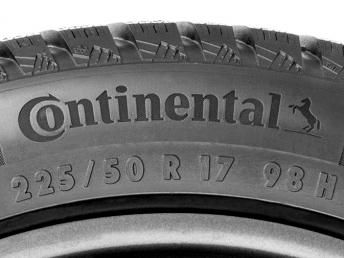How to Read Dot Code on Tires

What practise the numbers mean on the sidewall of your tire? At showtime glance, you look at your tire sidewall and think, "'Do I need a super secret decoder ring to read this?" In addition to the model proper noun of the tire at that place is a series of numbers that at first, you don't deem important. However, these numbers are extremely helpful, especially when it's time to replace your tires. Here's a quick breakdown to help yous decipher 1 of the best kept secrets in the automotive world: How do y'all read tire sizes?
TIRE SIZE
Example: P225/l/R17 98H
P identifies your tire as a Passenger Tire. The P stands for PMetric. If your tire size starts with LT rather than a P than it identifies the tire as a Light Truck tire.
225 identifies the tire department width, which is the measurement of the tire from sidewall to sidewall in millimeters. This measurement varies depending on the rim to which it is fitted.
(There are 25.4 millimeters per 1 inch.)
l is the two-figure aspect ratio. This percentage compares the tire's section tiptop with the tire'southward section width. For case, this aspect ratio of l ways that the tire's section height is 50% of the tire's section width.
R indicates the construction used within the tires casing. R stands for radial construction. B means belted bias and D stands for diagonal bias construction.
17 The last dimension listed in the size is the diameter of the bike rim, which is most often measured in inches.
LOAD INDEX AND SPEED RATING
Instance: P225/50/R17 98H
The load index and speed rating, or service description, are the numbers that follow the tire size.
The load index tells you how much weight the tire can support when properly inflated. Load indices range from 75 - 105 for passenger tires, with each numeric value respective to a certain carrying capacity. The conveying capacity for each value tin can be institute on a load index nautical chart. On each U.South. passenger motorcar tire, the load limit is listed in pounds. European tires have the load limit listed in kilograms and sometimes pounds.
H Speed ratings are represented past letters ranging from A to Z. Each alphabetic character coincides to the maximum speed a tire tin can sustain under its recommended load capacity. For instance, S is equivalent to a maximum speed of 112 mph. Even though a tire can perform at this speed, Continental Tire does not advocate exceeding legal speed limits.
| Rating | Maximum Speed |
| Q | 100 MPH |
| South | 112 MPH |
| T | 118 MPH |
| U | 124 MPH |
| H | 130 MPH |
| V | 149 MPH |
| W | 168 MPH |
| Y | 186 MPH |
| Z | Over 149 MPH |
DOT Series Number
The "DOT" symbol certifies the tire manufacturer's compliance with the U.South. Department of Transportation (DOT) tire prophylactic standards. Tires made in the United States have the DOT series number located on the inside sidewall well-nigh the rim.
Below is a description of the serial number. Starting with the year 2000, four numbers are used for the Date of Manufacture, the start two numbers identify the week and the last 2 numbers identify the year of manufacture. This identifies how erstwhile a tire is.
Prior to year 2000 three numbers are used for the engagement of industry, showtime 2 numbers place the week and the last number identifies the year of manufacture. To identify tires manufactured in the 90s, a decade symbol (a triangle on its side) is located at the stop of the DOT series number.
Source: https://continentaltire.com/learn/how-read-tire-sidewall
Postar um comentário for "How to Read Dot Code on Tires"